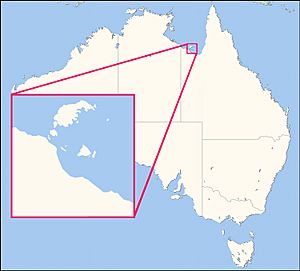Yukulta language facts for kids
Quick facts for kids Yukulta |
||||
|---|---|---|---|---|
| Ganggalida | ||||
| Region | Queensland | |||
| Ethnicity | Yukulta, Nguburinji | |||
| Native speakers | 1 full speaker (2007)e18 0 speakers (2004) |
|||
| Language family |
Macro-Pama–Nyungan?
|
|||
| Dialects |
Yukulta
Nguburindi
|
|||
| AIATSIS | G34 Ganggalida, G19 | |||
|
||||
The Yukulta language (also called Ganggalidda) was an Indigenous Australian language. It is now extinct, meaning no one speaks it as their main language anymore. It was spoken in parts of Queensland and the Northern Territory in Australia. The Yukulta people, who lived on the southern coast of the Gulf of Carpentaria, traditionally spoke this language.
Another language, Nguburinji, is thought to be a dialect of Yukulta. This means it was a different version of the same language, spoken by the Nguburinji people.
Contents
Language Family
Yukulta belongs to a group of languages called the Tangkic language group. Other languages in this group include Kayardild and Lardil. These languages are all from the North Wellesley Islands and the nearby mainland.
People who speak these languages can usually understand each other. The word tangka means "person" in all four Tangkic languages. Linguists (people who study languages) like Geoffrey O'Grady first grouped these languages together.
Experts like Nicholas Evans and Gavan Breen believe Yukulta and Nguburinji are two dialects of the same language. We know about Nguburinji from a list of words written down in 1897. About 90% of these words are the same as words in Yukulta today.
Language Sounds
Like all languages, Yukulta had its own set of sounds. These sounds are called phonemes.
Consonant Sounds
Yukulta had many different consonant sounds. These included sounds made with the lips (like 'p' or 'm'), the back of the tongue (like 'k'), and the front of the tongue (like 't' or 'n').
Vowel Sounds
Yukulta had three main vowel sounds: 'a', 'i', and 'u'. Each of these sounds could be short or long, which could change the meaning of a word.
How Words Change
In Yukulta, words often changed their endings. This is called morphology. It helped show what a word meant in a sentence.
Nouns and Adjectives
Nouns (like "dog" or "house") and adjectives (like "big" or "red") in Yukulta had a main part (the root) and an ending. These endings would change depending on how the word was used in a sentence. For example, the ending would show if a noun was the subject of a sentence or the object.
Pronouns
Yukulta had different kinds of pronouns (words like "I," "you," "he"). Some pronouns were "free," meaning they stood alone. Others were "bound," meaning they were attached to other words. These pronouns also changed their form depending on their role in the sentence.
Sentence Structure
The order of words in a Yukulta sentence was very flexible. This is because the endings on words already told you what their job was in the sentence. So, you could often put words in different orders and still understand the meaning.
Special Clauses
Yukulta used special markers for different types of sentences. For example, if you wanted to say "if..." or "because...", a small word or sound would attach to the first word of that part of the sentence.


